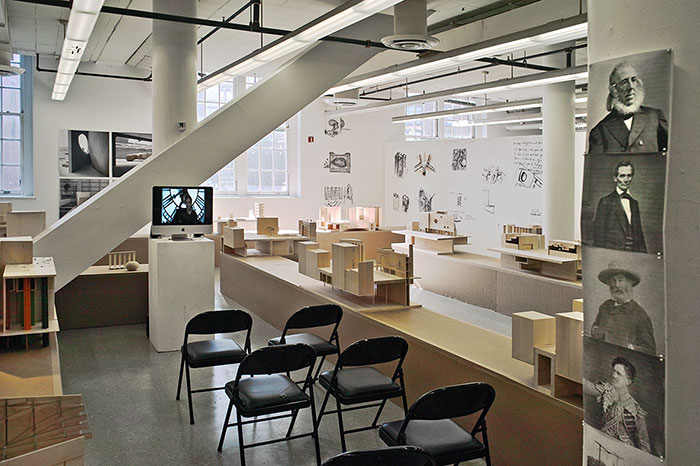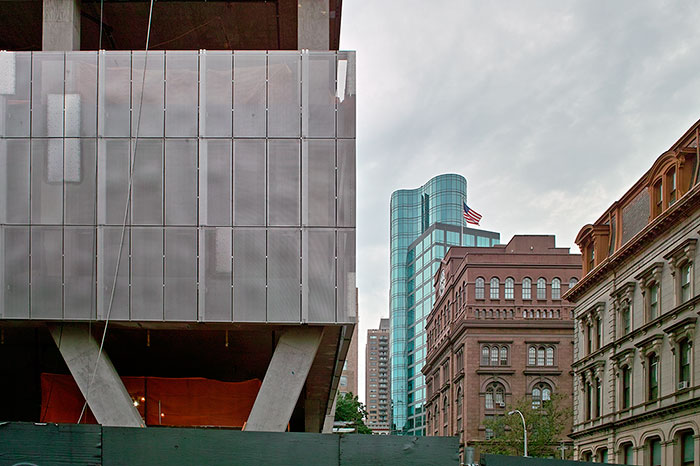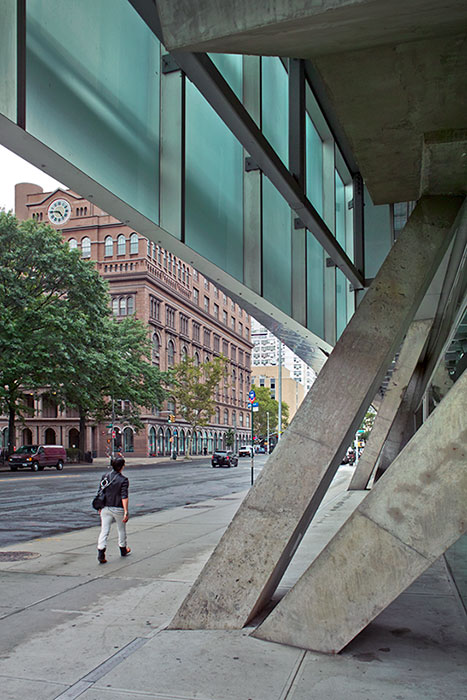
Recent student show in the architecture school — © Brian Rose
Portraits at right: Peter Cooper, Abraham Lincoln, Walt Whitman, Junius Brutus Booth (celebrated actor and father of John Wilkes Booth)
It is zero hour at Cooper Union.
Peter Cooper’s mission discarded:
Just two years ago, chairman of the board of trustees, Mark Epstein, announced that Cooper would cease being tuition free — for the first time in the school’s 156 year history — and Jamshed Bharucha, the recently installed president, was tasked with the “reinvention” of the school. The financial crisis that led to the imposition of tuition was caused by mismanagement, incompetency, and possible criminality, on the part of the board and the administration. The construction of the New Academic Building, among many other miscalculations, saddled the school with staggering debt. When questioned about the financial condition of the school, chairman of the board Epstein, showing stunningly poor leadership, blamed the alumni for not giving enough.
Students occupied the president’s office for weeks, only leaving when it was agreed that a working group would examine the school’s finances and propose a way to avoid tuition. The working group proposed a budget that called for sacrifice from everyone, and included greatly reducing Cooper’s bloated administrative costs. That proposal was rejected by the board of trustees, who seemingly did not understand the ramifications of their decision.
Death spiral:
The Cooper Union community, students, faculty, alumni, and others, remained steadfastly opposed to the reinvention of the school, which, aside from tuition, involved creating new revenue generating programs. A carefully researched lawsuit, enumerating past abuses, and accusing the board of violating the charter of the school, was brought to trial with a decision from the judge still pending. The alumni association was marginalized by President Bharucha, kicked out of its office on campus, denied access to its electronic mailing list, and for a time, not permitted to meet on campus.
The imposition of tuition immediately affected the school’s ability to attract the quality of students who had applied in the past. Admissions numbers plummeted. Prospective students began choosing other colleges over Cooper, some offering better financial incentives, and many offering far better amenities — factors that were not part of the equation before.
The administration and board lurched from one bad decision to another, at one point hiring the firm of Bo Dietl, a right wing blowhard, to take over the security of the campus, which included body guards for the increasingly paranoid president. Recently, the administration announced that it would begin charging for academic credits above a certain threshold — essentially a stealth increase in tuition. Confronted with protest, they withdrew the plan.
The Attorney General steps in:
Due to the lawsuit and the continued pressure put on by the Cooper community, the New York State Attorney General Eric Scheiderman began an investigation of Cooper Union, now teetering perilously on the brink. Members of the board of trustees began leaking misinformation to the press — most prominently, Daniel Libeskind and Francois de Menil — and the Murdoch-owned Wall Street Journal, in the process, further lowered its journalistic standards. In recent days, President Bharucha and his chief academic officer, Teresa Dahlberg have vanished from campus, and we now wait breathlessly for the next shoe to drop.

New Academic Building under construction and Foundation Building — © Brian Rose
What is at stake:
Thomas Jefferson wrote the epitaph for his gravestone with several brief phrases:
Author of the Declaration of American Independence
of the Statute of Virginia for religious freedom
& Father of the University of Virginia
Jefferson regarded the creation of his university one of his greatest achievements. It was, as he called it, an “academical village,” a place set apart where students and teachers would come together in the free pursuit of knowledge. Peter Cooper, a self-made inventor and entrepreneur, founded Cooper Union as his legacy, the gift of free education to the working class, the men and women who, in many cases, lived in the teaming slum neighborhood adjacent to the Foundation Building on the Bowery and the square now named after him. Unlike Jefferson’s rural village in the foothills of the Blue Ridge Mountains, Cooper’s institute was set in the heart of urban New York City.
Over the years, as the United States prospered and New York became one of the great cities of the world, Cooper Union became a more rarefied place, a free school open to all, but accepting only the highest qualified. Over the years, it has produced a notable share of the outstanding designers, builders, engineers, and artists in the city’s history.
The value of free:
Kevin Slavin, Cooper alumnus and MIT professor, has written eloquently about what free means in an educational context, a concept that those of us who attended Cooper Union understand intimately. Slavin writes:
“We went not because of the financial value of free — that is, zero tuition — but rather, because of the academic value of free. Free for everyone meant that the students who were there were beholden to nothing (nothing!) except their passion, talent, hard work, and brilliance. This unique, very particular sensibility — that, more than any other thing they could build, hire or install — this was the experience of the institution.”
Rebecca Mead writes in the New Yorker about Cooper “that It also grants a student the freedom to go in whatever direction her or his intellectual inclinations lead, without regard to the ultimate economic utility of the course of study. That learning should not necessarily be linked to future earning power is an ideal increasingly under siege in institutions of higher learning. Simply by embodying and demonstrating an alternative paradigm, Cooper Union benefitted even those who were not members of its student body.”

New Academic Building (foreground) and Foundation Buildiing — © Brian Rose
The end or a new beginning
Cooper Union’s future now hangs in the balance. The school’s current financial condition is grave and some doubt that it can survive as a tuition free institution, even were it to regroup and follow the working group’s plan. But it’s clear to me that it cannot survive with tuition. Cooper Union has no meaning, no purpose, beyond Peter Cooper’s vision of a school ” free as air and water.” It cannot compete with the juggernauts of American education, the Ivies, the well-endowed technical schools and art schools. Cooper’s survival depends on remaining what it was, free.
I am convinced, as of this writing, that an intervention by the Attorney General is the only way the school can be saved. It will require a reorganization of the school, a reaffirmation of the charter and founding ideals, and it will require some kind of grand bargain that will relieve the financial burden of debt that years of mismanagement have wrought. If that grand bargain cannot be reached — in this moment of New York City financial ascendency — I fear that Peter Cooper’s great educational gift will be squandered and his legacy forever dishonored.
Thank you for this passionate and eloquent summery of events. My sentiments exactly.
I still hold out hope.
Denise
Art 93′
Very sad. It could almost be forgiven (not really) if that monstrosity of a building were, in fact, anything worth looking at (kind of embarrassing for a cultural institution meant to advance the future of architecture). As it is, perhaps they could gather a quick dollar or two from disassembling and selling the steel and concrete to the military for a bunker in our next ill advised, international foray.